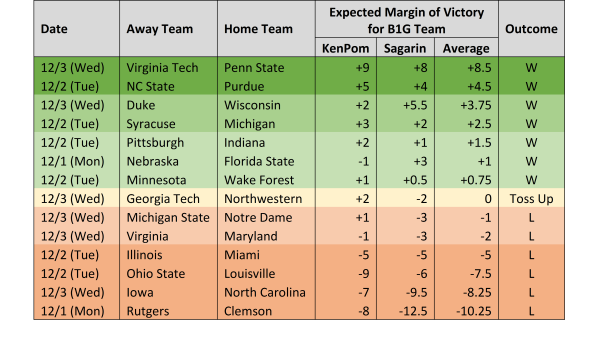Expected Outcomes: Predicting the Big Ten/ACC Challenge
Posted by Alex Moscoso (@AlexPMoscoso) on December 1st, 2014Once again, the Big Ten/ACC Challenge is upon us. The annual event pits the best conference in the country against a conference that houses an institution of dubious academic integrity. Both the Big Ten and ACC have new entrants in their respective leagues, including one crossover in Maryland, which should provide for more intriguing storylines. It also means that the Challenge expanded its slate from twelve to fourteen games. In this post, I examine all fourteen matchups by using both KenPom and Sagarin ratings to determine which of the games are more heavily favored to go into the Big Ten’s side of the ledger as a win, and which ones are long shots for our conference. The table below shows the expected margin of victory for each Big Ten team — negative numbers obviously means a loss — from both ratings and their average, which we will use as our primary barometer. (Home court advantage is reflected in these margins).
According to the average point differential and subsequent outcomes, this analysis expects another close Challenge with the Big Ten winning seven games, the ACC winning six games, and one toss-up game. Individually, KenPom has Big Ten winning the Challenge 8-6, while Sagarin has it tied at 7-7. A majority of these games are expected to be close, with six of the games having an average point differential of one bucket (two points) or less. Ironically, Penn State – a perennial bottom dweller in the Big Ten — is the biggest favorite to win their matchup as they have home court advantage against a Virginia Tech team with losses to Appalachian State and Northern Iowa. The other expected wins for the Big Ten are made up of teams with home court advantage over competitive ACC teams (Wisconsin/Duke and Michigan/Syracuse) and teams who are playing bad ACC teams (Minnesota/Wake Forest. and Nebraska/Florida St.). Some of the Big Ten’s well performing teams have unfavorable matchups against competitive opponents on the road (Illinois/Miami and Ohio State/Louisville). Finally, the biggest longshot for a Big Ten win is Rutgers, who is a 10-point underdog to a Clemson team that already has losses to Winthrop and Gardner-Webb. So in case you were wondering who the worst team from both conferences was, look no further than Eddie Jordan’s squad.
We all know things will not go as planned and there will be inexplicable upsets during the next three nights. Look no further than last year’s upset of, at the time, a surging Michigan State at home by a North Carolina team that had lost to Belmont and UAB. But the table provides a pretty good tally and pecking order of games with their likely outcome. It can also provide insight on what games to watch if the Big Ten does get upset in a game and needs to pull out an upset of its own. For example, if Nebraska loses in Tallahassee on Monday night, the Big Ten will have to pick up another win to at least go for a tie in the challenge, the most likely of which would be Northwestern protecting their home floor against Georgia Tech on Wednesday night. The table will help you keep score as the Big Ten tries to avoid a tie for the third straight year and win its first Challenge outright since 2011.













































